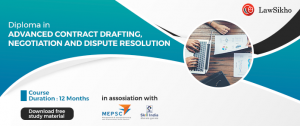This article is written by Subham Mund pursuing a Diploma in Advanced Contract Drafting, Negotiation, and Dispute Resolution from Lawsikho.
Table of Contents
Introduction
Technology has taken the world by storm in the past few decades and with the addition of globalization in the mix, this phenomenon does not seem to show any signs of slowing down in the near future. With the advancements in the field of science, the demand for these products and the associated sectors has also grown to a great extent. The above-mentioned phenomenon has also resulted in the growing popularity of intellectual property rights. Intellectual property rights in the simplest terms can be understood as the product of the mind that cannot be physically perceived like tangible property. Intellectual property rights are of various types such as copyright, patent, design and so on. The primary reason behind the existence of IPR law is to protect the interest of IP holders and to provide an incentive for their efforts.
In order to understand the concept of a grant back license agreement, we must first understand the definition of the term patent. A patent can be defined as a kind of IP that gives its holder/owner the legal right to exclude others from making, using, or selling an invention for a limited period of years, in exchange for publishing an enabling public disclosure of the invention. Patents are filed to protect the proprietor’s interest with regards to a new invention that has inventive steps, is non-obvious, and novel and has industrial application.
Grant-back license is usually associated with a patent agreement. I would like to explain the meaning of this agreement with the help of an illustration. Two of the major players in the gaming industry are Playstation and Xbox and these two companies launched their latest and greatest consoles a few months back namely Playstation 5 and Xbox Series X both of these devices are composed of a custom build AMD developed graphical processing units. Now as per the agreement both the companies may customize the GPU as per their requirements now if AMD finds this customization useful it may use the same in its future products. In the above-mentioned example, AMD is the Licensor and PlayStation and Xbox are Licensees because AMD has allowed them to use its Patent but the patent remains with AMD.
In simple terms, a grant-back license agreement can be understood as an agreement that bestows an obligation upon the licensee to license any improvements made in the patent of the original licensor. The grant-back clause is common in technology license agreements in many industries. Grant-back clauses typically arise in the context of the licensing of patented technology.
Grant-back licenses are broadly considered as a reasonable method of safeguarding a technology licensor’s interests while promoting the licensing of the fundamental technology. An adequately drafted grant-back license can foster the licensing of technology by eradicating the fear that the licensor could find itself competing with a licensee who has developed an improvement to its technology. However, an ill drafted grant-back clause risks being seen as an anti-competitive provision that restricts innovation.
How are these agreements drafted?
A grant-back license agreement is an IPR based document that mostly relates to patents. As mentioned above, all IPRs are aimed at securing a better interest mostly for the proprietor but the underlying principle behind this is to protect and promote creativity. Keeping this in mind, we can agree that a Grant-Back License agreement should protect the interest of the licensor but it should not be so restrictive in nature that it stifles innovation. A balance between both parties must be obtained for a fair agreement to take place.
A lot of factors come into play while determining if the agreement is reasonable or not like the term of the license agreement. For instance, if the term of grant-back license agreement is longer than the term of patent itself then the agreement can be termed as unreasonable. Key aspects include; the relationship of the improvement to the licensed technology, whether the grant-back license is exclusive or nonexclusive.
The necessity for grant-back license agreement
Grant back license agreement is entered into by parties because it creates a win-win situation for both parties. As a licensor, the party not only gets paid for licensing their patent but also has an opportunity to get their hands on an improved version of the same technology without spending any resources on their part. At the same time, this agreement eliminates the possibility of competition from a licensee. Similarly, there are benefits for the licensee as well because with a grant-license agreement they are given the license to use a patent registered in the name of the licensor in addition to that there also given the liberty to customize the same as per their needs and requirements thus having the freedom to apply their intellectual mind.
Problems faced during drafting a grant-back license agreement
While drafting a grant-back agreement a lot of challenges may be faced. Some of those challenges are listed as below:
-
Term of the agreement
It is essential to outline the terms of the agreement from the get-go because if it is not mentioned in a clear manner it may lead to issues later. The term may be less or equal to the entirety of the term of the patent.
-
Need for expertise
Grant-back license agreements are essentially based on patent licensing and it is a well-known fact that patent is a very technical topic and in order to draft an effective agreement, it is a basic requirement that the drafter is well versed with the technology itself to better assess the rights of the parties involved.
-
Vagueness of terms
The contract must explicitly draw out all the necessary rights and limitations in a precise manner in order to avoid confusion down the line. In addition to that patent is a very technical matter, to begin with, so when a license agreement involving a patent is drafted loosely can have severe repercussions.
Essential clauses in a grant-back license agreement
The essential clauses of a grant-back license agreement are as follows:
Parties and recital
- The agreement should clearly mention the names and essential contact details of the parties involved.
- It should be mentioned whether the agreement is exclusive or not
- It should also draw clear scope of the agreement
Definition
Definition clause is not an absolute necessity but it can be very helpful in defining certain words in the contract which may be ambiguous or may be interpreted in a way other than the intention of the drafter. As discussed above, a patent can be a complicated document so it becomes fairly necessary to define certain words.
Grant-back license
This clause sets out the exact terms of the agreement between the parties involved in detail like the exclusive or non-exclusive, revocable or irrevocable and other information like sub-licensability, transferability, information about the royalty fees etc. It should also give the full detailed information about the patent and its rights and limitations should also be mentioned explicitly.
Transfer of license
This clause should expressly mention the procedure which is to be followed in transferring the license. It can also include the term of the agreement
Notification clause
This clause should include the detailed steps or processes in which a notice is to be served in case a party wants to terminate the contract.
No implied rights
Parties may declare explicitly that no rights which are not mentioned in the agreement will be implied.
Dispute resolution
This clause must answer when, where and how the disputes arising between the parties should be settled.
For instance, it can provide that in case of a dispute, an internal informal meeting for dispute resolution should happen. Following this, mediation or arbitration can be used for dispute resolution. The clause should clearly specify how the mediator or an arbitrator would be appointed and the rules that would be followed during this process. It can also provide for litigation and specify the court which has jurisdiction to look into this case.
Termination clause
This clause should cover how and when the agreement can be prematurely terminated. It should be specified whether either party can terminate the agreement and the circumstances in which they can do so. It should also provide details regarding the penalty to be imposed upon the party who prematurely terminates the agreement.
For instance, it can allow the parties to terminate the agreement if a clause of the marketing agreement has been violated. It can allow the business to terminate it if the marketer does not perform up to standards and fails to meet the required results. Similarly, the marketers can be allowed to terminate the agreement if the business does not give proper instructions to it or rips them of their intellectual property.
Miscellaneous
A miscellaneous clause may be added in the agreement to define certain aspects of the agreement which are not discussed in previous clauses such as governing law, severability, waiver and so on.
Conclusion
Grant-back licence agreements when well drafted could not only protect the interest of the licensor but also help the licensee because they get access to patent technology. This helps in the advancement of technology as more entities get access to the patent. And the original proprietors don’t have to feel threatened by the licensee.
References
- https://www.lawctopus.com/academike/definition-license/
- http://biodieselmagazine.com/articles/8888/the-grant-back-clause-in-your- technology-license
- https://www.investopedia.com/terms/p/patent.asp
- https://www.lawinsider.com/clause/grant-back-license
- https://www.sec.gov/Archives/edgar/data/1438231/000119312511054776/dex1013.htm
Students of Lawsikho courses regularly produce writing assignments and work on practical exercises as a part of their coursework and develop themselves in real-life practical skills.
LawSikho has created a telegram group for exchanging legal knowledge, referrals, and various opportunities. You can click on this link and join:
 Serato DJ Crack 2025Serato DJ PRO Crack
Serato DJ Crack 2025Serato DJ PRO Crack











 Allow notifications
Allow notifications



